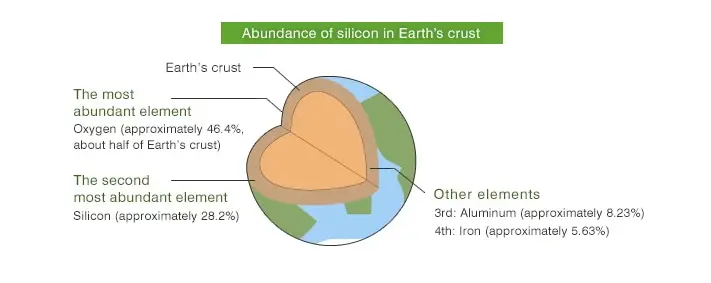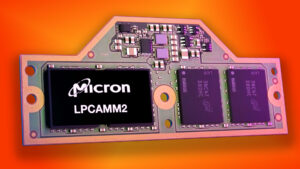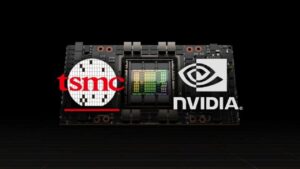Introduction:
Semiconductors play an indispensable role in our daily lives, powering a myriad of electronic devices we use, from personal computers and smartphones to televisions and digital cameras. At the heart of these semiconductors lies silicon, an element abundant in nature, yet meticulously extracted and purified for its application in modern electronics. In this blog post, we delve into the fascinating world of silicon wafers, its extraction, purification, and its crucial role in the semiconductor industry.
The Abundance of Silicon:
Silicon, denoted by its chemical symbol Si, ranks as the second most abundant element on Earth, surpassed only by oxygen. It is omnipresent, found not only in soil and rock but also in natural water, trees, and plants. However, in its natural state, silicon exists as compounds with oxygen, aluminum, and magnesium, necessitating the extraction and purification processes to obtain the pure crystalline form required for semiconductor manufacturing.

Image Credits: Hitachi
The Quest for Purity:
To be employed in semiconductor technology, silicon must undergo rigorous purification, aiming for an ultra-high-purity level of “99.999999999%”—affectionately referred to as “eleven nines.” This level of purity ensures a flawless crystal lattice, which is fundamental to semiconductor functionality.
Follow us on Linkedin for all major updates
Crystal Lattice: The Foundation of Silicon’s Stability:
A single crystal structure is vital for silicon’s stability and functionality in semiconductors. Moreover, the crystal lattice of silicon, known as a diamond cubic crystal structure, is a repeating pattern of eight atoms. Additionally, each silicon atom forms four strong bonds with neighboring silicon atoms, creating an orderly, continuous arrangement. Consequently, this stable structure underpins silicon’s reliability and performance in electronic devices.
The Extraction and Refinement Journey:
Moreover, extracting silicon in its purest form is a power-intensive process. Additionally, refined silicon, or ingots, with a minimum purity of 98%, is often imported from countries like Australia, China, and Brazil, where electricity is relatively affordable.Subsequently, this extraction and refinement process involves converting silicon compounds into raw silicon, followed by meticulous purification to achieve the desired ultra-high-purity level necessary for semiconductor applications.

How Silicon Wafers are Created?
Silicon wafers are essential components in the manufacturing of various electronic devices, including integrated circuits, solar cells, and other semiconductor-based devices. The process of producing silicon wafers involves several key steps:
Silicon Extraction: Silicon is derived from silicon dioxide (SiO2), which is abundant in nature as sand or quartz.In an electric furnace, carbon typically extracts silicon through a chemical reduction process.
Purification and Conversion to Metallurgical Grade Silicon: The extracted silicon is then purified to remove impurities like oxygen, carbon, and metals. Manufacturers call this purified silicon “metallurgical-grade silicon.”
Conversion to Semiconductor-Grade Silicon: Furthermore, the metallurgical-grade silicon undergoes a refining process, usually via the Siemens process or the fluidized bed reactor (FBR) process, to produce semiconductor-grade silicon.. This involves reacting the silicon with a gaseous source of a highly pure silicon compound, such as trichlorosilane (SiHCl3), at high temperatures.
Czochralski Growth or Float-Zone Refining:
They use semiconductor-grade silicon to grow single crystals through processes such as the Czochralski method or float-zone refining. In the Czochralski method, the operator dips a seed crystal into molten silicon and then slowly pulls it upwards, enabling the growth of a single crystal of silicon from the melt.. Float-zone refining involves passing a high-frequency electromagnetic field through a rod of silicon, melting and purifying it to form a single crystal.
A precision saw or wire saw performs the task of slicing the resulting single crystal of silicon into thin, circular discs known as silicon wafers. Additionally These wafers are typically between 200 and 300 micrometers thick, depending on the intended application.
Grinding and Polishing: The rough-cut wafers undergo grinding and polishing processes to achieve the desired thickness and a smooth, flat surface. This step is crucial for ensuring the wafers meet stringent quality standards necessary for semiconductor fabrication.
Cleaning and Inspection: They clean the wafers thoroughly to remove any contaminants or residues from the manufacturing process.Inspectors then examine them to ensure they meet the necessary specifications for electrical properties, thickness, and surface quality.
Doping and Other Processing: Depending on the specific application, the wafers may undergo additional processes, such as doping with specific elements to modify their electrical properties. This is a critical step in the fabrication of transistors and other electronic components.
After completing these steps, manufacturers can use the silicon wafers in the production of various semiconductor devices.

Image Credits: PerkinElmer
Understanding the Role of Gates in Transistors: A Comprehensive Guide – techovedas
Conclusion:
Silicon, the ubiquitous element abundantly available in nature, serves as the bedrock of the semiconductor industry. Meticulous extraction and purification processes transform silicon into an ultra-high-purity crystalline structure, enabling the creation of intricate semiconductor devices that power our modern world. Understanding the journey from raw silicon to advanced semiconductors sheds light on the vital role this remarkable element plays in shaping our technologically advanced society.




